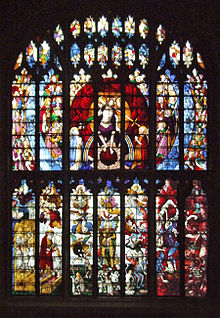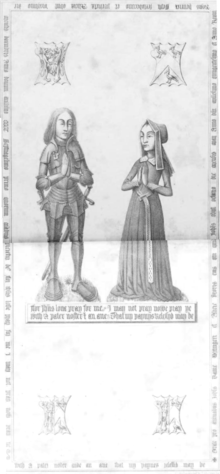
Lechlade is a town at the edge of the Cotswolds in Gloucestershire, England, 55 miles (89 km) south of Birmingham and 68 miles (109 km) west of London. It is the highest point at which the River Thames is navigable, although there is a right of navigation that continues south-west into Cricklade, in the neighbouring county of Wiltshire. The town is named after the River Leach that joins the Thames near the Trout Inn and St. John's Bridge.
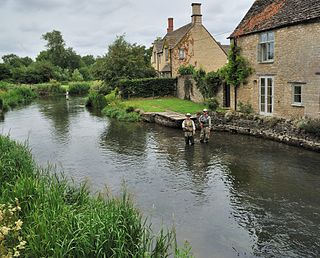
Fairford is a market town in Gloucestershire, England. The town lies in the Cotswold hills on the River Coln, 6 miles (9.7 km) east of Cirencester, 4 miles (6.4 km) west of Lechlade and 9 miles (14 km) north of Swindon. Nearby are RAF Fairford and the Cotswold Water Park.

A wool church is an English church financed primarily by donations from rich merchants and farmers who had benefitted from the medieval wool trade, hoping to ensure a place in heaven due to their largesse.

Lady Isabel Neville was the elder daughter and co-heiress of Richard Neville, 16th Earl of Warwick, and Anne de Beauchamp, suo jure 16th Countess of Warwick. She was the wife of George Plantagenet, 1st Duke of Clarence. She was also the elder sister of Anne Neville, wife and consort of Clarence's brother, Richard III.

The region now known as Gloucestershire was originally inhabited by Brythonic peoples in the Iron Age and Roman periods. After the Romans left Britain in the early 5th century, the Brythons re-established control but the territorial divisions for the post-Roman period are uncertain. The city of Caerloyw was one centre and Cirencester may have continued as a tribal centre as well. The only reliably attested kingdom is the minor south-east Wales kingdom of Ergyng, which may have included a portion of the area. In the final quarter of the 6th century, the Saxons of Wessex began to establish control over the area.

Northleach is a market town and former civil parish, now in parish Northleach with Eastington, in the Cotswold district, in Gloucestershire, England. The town is in the valley of the River Leach in the Cotswolds, about 10 miles (16 km) northeast of Cirencester and 11 miles (18 km) east-southeast of Cheltenham. The 2011 Census recorded the parish's population as 1,854, the same as Northleach built-up-area.
This is a list of Sheriffs and High Sheriffs of Gloucestershire, who should not be confused with the Sheriffs of the City of Gloucester.

Rendcomb is a village in the Cotswold local authority area of the English county of Gloucestershire. It is about five miles north of Cirencester in the Churn Valley.
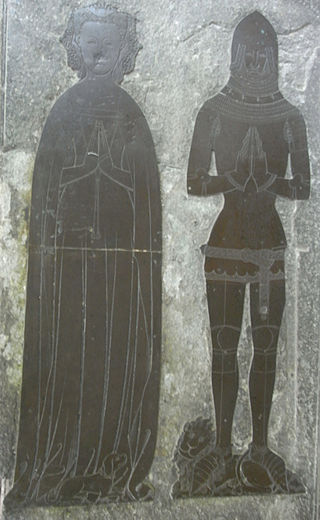
Thomas de Berkeley, 5th Baron Berkeley, The Magnificent, of Berkeley Castle and of Wotton-under-Edge in Gloucestershire, was an English peer and an admiral. His epithet, and that of each previous and subsequent head of his family, was coined by John Smyth of Nibley (d.1641), steward of the Berkeley estates, the biographer of the family and author of "Lives of the Berkeleys".
Sir Walter Buckler was a diplomat, chamberlain of the household to Lady Elizabeth, later Queen Elizabeth I, and private secretary to Catherine Parr, the sixth wife of King Henry VIII.

William Fermor, 1st Baron Leominster, styled Sir William Fermor, 2nd Baronet from 1661 to 1692, was an English politician and peer.

Sir William Denys of Dyrham, Gloucestershire, was a courtier of King Henry VIII and High Sheriff of Gloucestershire in 1518 and 1526. The surname is sometimes transcribed as Dennis.
Samuel Rudder was a Gloucestershire topographer, printer and antiquarian who was born at Uley and baptised 5 December 1726. He was the son of Roger Rudder, a shopkeeper and pig-killer. Rudder ran a printing and bookselling business in Cirencester in the 1750s and wrote and published several works on the history of Gloucestershire.
The Manor of Dyrham was a former manorial estate in the parish of Dyrham in South Gloucestershire, England.

John Greville was a Member of Parliament for Gloucestershire in seven parliaments.
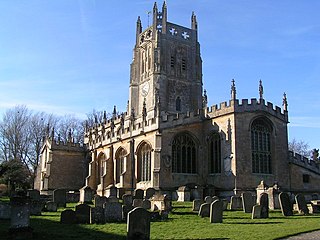
The Fairford stained glass is a set of 28 pre-Reformation stained glass windows located in St Mary's Church, Fairford, Gloucestershire. The medieval stained glass panes are of national historical and architectural importance as they constitute what is "probably the most complete set of medieval stained glass in Britain" consisting of 28 windows displaying biblical scenes. They were added after the church had been rebuilt by the wealthy wool merchant John Tame (c.1430–1500). The glass was made between 1500 and 1517 under the instructions of his son, Edward Tame.
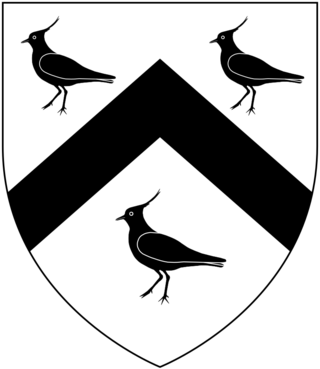
John Twynyho of Cirencester, Bristol and Lechlade, all in Gloucestershire, was a lawyer and wealthy wool merchant who served as Recorder of Bristol, as a Member of Parliament for Bristol in Gloucestershire in 1472-5 and in 1484 and for the prestigious county seat Gloucestershire in 1476. In 1478 he was Attorney General to Lord Edward (the future King Edward V, eldest son and heir of King Edward IV.

William Greville, of Chipping Campden in Gloucestershire and a Citizen of the City of London, was a prominent wool-merchant and is the ancestor of the present Greville Earls of Warwick. The Latin inscription on his ledger stone in Chipping Campden Church, which he rebuilt at his own expense, describes him as flos mercatorum lanar(iorum) tocius (totius) Angli(a)e, "the flower of the wool-merchants of all England". This language is reminiscent of that used to describe certain prominent knights such as Edward, the Black Prince (d.1376) who was described by Froissart as la fleur de toutte chevalerie dou monde and was likely intended to suggest a degree of equivalence between mercantile and martial activities". He was amongst the richest and most influential wool merchants of his era and was the leading purchaser of wool from the Cotswold Hills.

St Mary's Church is a Church of England church in Fairford, Gloucestershire, England. It is notable for its complete set of 28 medieval stained-glass windows, one of the best-preserved in England. Part of the tower dates from the early 15th century. The church was rebuilt at the end of the 15th century by John Tame (c.1430–1500), a wealthy local wool merchant. It is a Grade I listed building in the Perpendicular style.

The title Baron Cobham has been created numerous times in the Peerage of England; often multiple creations have been extant simultaneously, especially in the fourteenth century.



